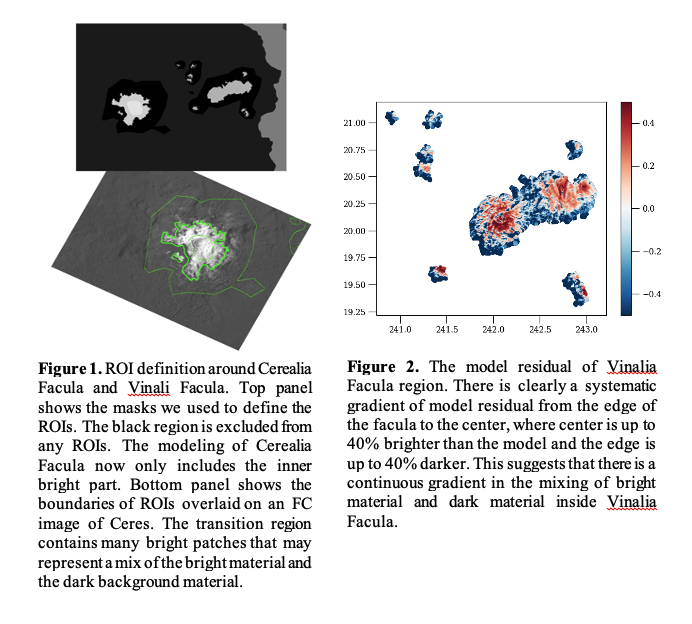Inside the Occator Crater Region: A Spectrophotometric Analysis
- 1Planetary Science Institute, Tucson, United States of America (zouxd@psi.edu)
- 2Sun Yat-sen University, Zhuhai, China
- 3Deutsches Zentrum für Luft- und Raumfahrt (DLR), Berlin, Germany
- 4Luleå University of Technology: Luleå, Norrbotten, Sweden
Introduction:
We have performed a detailed spectrophotometric modeling and mapping of three geologically young regions on Ceres, including the one of the youngest craters, Haulani[1], the cryovolcanic Ahuna Mons[2], and the Occator crater region. We aim to identify potential cryovolcanic features and constrain geologic processes on Ceres. The focus questions include 1) How does light scattering, such as photometric phase functions and their color dependence, reflectance, and albedo relate to grain size and packing, surface roughness and composition? 2) How do spectrophotometrically distinct geologic units further relate to putative cryovolcanic or cryomagmatic features or other processes/landforms? and 3) Are the peculiar light scattering properties of Cerealia Facula related to active haze forming over the region?
We have reported our results for the Haulani crater and Ahuna Mons previously [3,4]. Different from these two areas, Occator crater region is much more complicated than the other two in terms of photometric modeling because of the diverse compositional variations within this crater including the faculae, the drastic albedo contrast between the faculae and the background region, and the diffuse nature of the bright material especially in the Vinalia Facula. The Cerealia and Vinalia Faculae inside the Occator crater region, which are carbonate- and chloride-rich evaporites [5] formed from brine extrusion with evidence of recent activity [6]. In this report, we will discuss the photometric behavior of the Facula regions and compare it to other regions.
Analysis of Occator region:
The different regions must be divided such that the photometric behavior within each ROI is relative uniform. We went through many iterations to define the ROIs, particularly for the faculae and the surrounding areas. We finally decided to exclude the transition region surrounding the Cerealia Facula from any ROIs, because including that region into either the facula ROI or crater floor ROI would significantly degrade the model quality. The possible reason could be that the transition region contains a mix of the bright facula material and the dark crater floor material in the spatial scale below the pixel resolution. Although visually undiscernible, the mix significantly changes the photometric behavior of either the facula material or the crater floor material. The modeling quality for Cerealia Facula and crater floor has been significantly improved with this ROI definition. The Vinalia Facula is diffuse in nature, and therefore a satisfactory model cannot be derived (Fig. 2).
Following the same procedure as for the previous two regions, we performed modeling to the ROIs in the Occator region. The modeled parameters based on the final ROI definitions, with the roughness parameters fixed to 20º, are shown in Fig. 4. Overall, the models for Cerealia Facula and Vinalia Facula were improved from the previous results but not fully satisfactory. For example, the roughness parameter, if set free, returned all zero for Cerealia/Pasola faculae, in contrast to the previously reported results that the bright material may display a high roughness [7]. The asymmetry factor values have a large range of oscillation with respect to wavelength rather than a trend, which is another indication that the modeling is not reliable. That is why we need to perform a more careful analysis to determine the photometric behavior of the bright material, utilizing higher resolution images and terrain model. Generally, we performed a preliminary synthesis analysis with the preliminary results of the Occator regions. It appears that the overall trend that showed up for the Haulani crater region and Ahuna Mons region still hold, but some inconsistency exists. In particular, the whole Occator region appears to be redder than other regions in terms of SSA, which is inconsistent with previous results (e.g.,[8]). We also compared the differences and similarities between regions, further interpretation will benefit in the context of Ceres’s geologic activity and cryovolcanic history.
Acknowledgments: This research is supported by NASA Grant #80NSSC21K1017. All data used in this study are directly downloaded from the Small Bodies Image Browser (SBIB) from the PDS small body node Asteroid/Dust Subnode.
Reference:
[1] Krohn K. et al. (2018) Icarus 316, 84.
[2] Ruesch O. et al. (2016) Science, 353, 1005.
[3] Li, J. Y., et al. (2022). EPSC 2022
[4] Zou, X.D., et al. (2023) LPI Contributions, 2806, p.1936.
[5] Raponi A. et al. (2019) Icarus, 320, 83.
[6] De Sanctis M.C. et al. (2020) Nature Astron. 4, 786.
[7] Li, J. Y., et al. (2016). Astrophys. J. Lett. 817, 22.
[8] Schröder, S.E., et al., (2017) Icarus 288, 201-255.

How to cite: Zou, X.-D., Li, J.-Y., Mest, S., Kargel, J., Mottola, S., and Schröder, S.: Inside the Occator Crater Region: A Spectrophotometric Analysis, Europlanet Science Congress 2024, Berlin, Germany, 8–13 Sep 2024, EPSC2024-296, https://doi.org/10.5194/epsc2024-296, 2024.